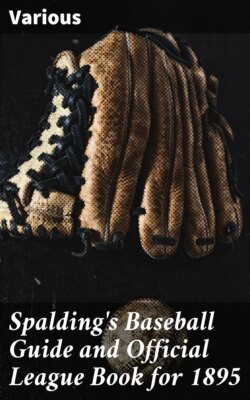Читать книгу Spalding's Baseball Guide and Official League Book for 1895 - Various - Страница 5
На сайте Литреса книга снята с продажи.
INTRODUCTION.
ОглавлениеTable of Contents
The decade of the nineties in League history bids fair to surpass, in exciting events, that of every preceding series of years known in the annals of professional base ball. The decade in question began with the players' revolt in 1890 and was followed up by the secession of the old American Association, a fatal movement, which ended in the death of that organization in the winter of 1891–92; the reorganization of the National League resulting in the absorption of the best half of the old Association clubs and the beginning of the experiment of governing the whole professional fraternity by one major League instead of by a dual government as before; this one powerful League being itself controlled by the laws of the "National Agreement." The cost of the amalgamation of the four American Association clubs with the National League, together with the financial losses incurred by the revolutionary period of 1890 and 1891—losses, by the way, which the players did not participate in, the clubs alone being the sufferers—left a heavy burden of debt to handicap the reconstructed National League in its efforts to recover the public confidence in professional ball playing lost by the malcontents of 1890 and 1891. But, nevertheless, the seasons of 1892 and 1893 saw the heavy indebtedness removed from the League's shoulders; and in 1894 the flourishing financial times of 1888 and 1889 were, in a measure, renewed, and for the first time since the Brotherhood revolt of 1890, the professional base ball business in 1894 became a paying investment.
It will scarcely be believed that, in the face of the financial losses incurred during the revolutionary period of 1890 and 1891, that the closing part of the season of 1894 saw another attempt made to renew the troubles of 1891, by an effort made to resuscitate the defunct American Association under the banner of "Death to the League's reserve rule," together with that of a joint attempt made to revive the old Brotherhood plan of rival League clubs in the larger base ball cities of the Union. This revolutionary effort, made by one of the promoters of the revolt of 1890, aided by two dismissed managers and a disgruntled star player itching for notoriety at any cost, led the magnates of the National League to adopt repressive measures calculated to put an end to any future revolutionary efforts of the kind, by severely punishing any League club manager or player who should prove recreant in fealty to the laws of the National Agreement, or who should join in any attempt to organize any base ball association opposed to the reserve rule, which rule over ten years' experience had proved to be the fundamental law and corner-stone of the professional base ball business. Without such a repressive law it was evident that the League would be subject to periodical attempts on the part of unscrupulous managers or players to war upon the reserve rule for blackmail purposes. The necessity for some such law was made evident by the recent efforts made to organize a new American Association on the basis of not only warring upon the reserve rule but of trespassing on the territorial rights of existing League clubs.
#The League Manifesto of 1894.#
The finale to the annual meeting of 1894 was the issuing of a manifesto by the National League, which was called forth by an effort at treachery in the League ranks which required prompt action for its repression. This manifesto was issued without regard to efforts to organize a new American Association, any opposition of the kind to the National Agreement clubs, with the major League at its head, being looked upon as futile, owing to the character of the men alleged to be at the head of the movement; the main incentive of the League magnates being to publicly announce what the penalty of treachery to National Agreement interests would be in the future. The manifesto in question was the work of a special committee appointed by the National League at its annual meeting in November, 1894, which consisted of Messrs. Chas. H. Byrne, H. R, Von der Horst, James A. Hart and John T. Brush.
The following is the statement drawn up by the committee, and referred to the National Board for adoption:
